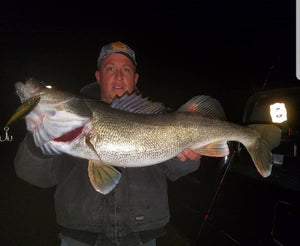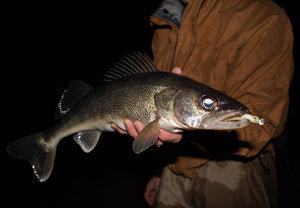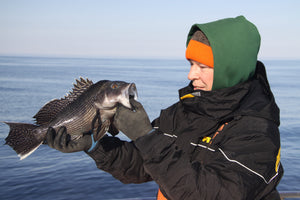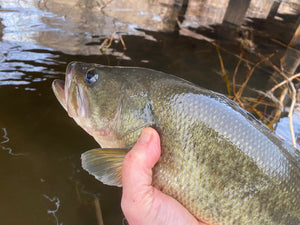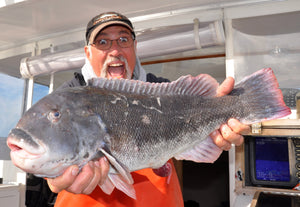The Time Is Right For Tidal Whites

Strip a striper of its stripes and what you've got is your basic white perch, both in attitude and appearance. Indeed, from a biological standpoint, Morone saxatilis (stripers) and Morone Americana (white perch) are close cousins. The big difference between the two is size, of course. While a striper may push past 50 pounds, a big white perch measures 12 to 14 inches and a "typical" specimen is six to nine inches long. Still, it’s important to note the difference between the two since some smaller stripers will winter over in the same tidal creeks favored by the perch. The bass, of course, need to be released while out of season. The perch, however, currently have no size or bag limits but most who seek them are careful to return the vast majority of their catch as the white’s numbers have declined steadily in recent years which may be a function of fishing pressure, among other causes.

Photo by Tim Regan (@SouthForkSalt)
PREMIUM CONDITIONS
So, what do you need to bring the perch up into the brackish waters of tidal creeks and rivers where they can be caught from the bank, a kayak or even a small boat? First and foremost is suitable water temperature with 50 degrees about perfect and five degrees warmer or up to ten degrees cooler acceptable.
Next in importance is a rising tide. White perch like to move upriver and patrol the slopes and edges of channels and holes, but they do so generally on incoming water. Falling tides force the fish to retreat toward mid-creek and deeper water, usually away from the bank. (This can, of course, be an opportune time for boaters to find them schooled tightly in a deep hole.)
While the first hour of the ebb is frequently productive, it's generally no match for the last half of incoming water. Indeed, the best perch spots in tidal creeks are often the deep-water side of bends where the current has gouged the bank. As a rule, perch prefer areas with slow to moderate flow. Given the right conditions they may roam upstream a mile or more from salty waters.
In addition to rising tides, suitable water temperature and the proximity of deep water, there is one other major requirement needed to bring the perch around: a strong forage base. White perch are opportunistic predators. They’ll feed on krill, grass shrimp, nymphs, worms or other such simple fodder, but they'll flock to a pod of small killies or wintering spearing. Thus, they like to inhabit tidal waters that are alive and thriving. Some creeks, canals and back water marsh edges hold killies and shiners throughout the winter and these are the ones most likely to interest perch.

Photo by Tim Regan (@SouthForkSalt)
LIGHT TACKLE BEST
While generally small compared to most desirable species of saltwater fish, white perch can be a real battlers if you give them a fighting chance. Because of the lightweight jig, lures and baits used to catch them, using featherweight gear in the 4- to 6-pound class makes a lot of sense. Consider a four-pound-class spinning outfit along the lines of a St. Croix X-Trek, or Daiwa Crossfire LT combo. Either setup will be ideal for casting the tiny jig sizes usually associated with this kind of fishing while stilling having the fortitude to turn a big perch that's headed for a break in the reeds. If you have a specific setup you like for stocked trout or freshwater panfish, that should serve fine as well so long as it’s on the lighter side.
TEMPTING TECHNIQUES
Depending on where you fish and the bait used, rigging options for tidal perch vary slightly. For shallow water fishing in slow currents, simply tie a pre-snelled #6 beak or sproat style hook to the end of your line and add a float two- to three-feet above the hook to keep the bait off the muddy bottom. For deep-water action or to deal with faster currents, pinch a split shot or two on the line about two feet ahead of the hook or anchor a small bottom rig with a small bell sinker. With either of these rigging options, you can impale a 2-inch segment of night crawler, a pair of small grass shrimp, or a small live killie hooked through the lips.
Any of the above baits should be cast out toward productive looking water and allowed to set for up to five minutes (or to drift with the current as long as practical). Laking any takers by that point, slowly work the bait back to shore or your boat. Make certain to keep your retrieve slow the entire way - and don't give up early because white perch do have a habit of striking just before the hook is lifted from the water.
One of the truly nice personality traits of white perch is their willingness to also smack lightweight lures. We’ve caught them on small in-line spinners, tiny Rapalas, and the smallest of crankbaits. Still, it’s tough to beat a 1/8-, 1/16- or 1/32-ounce lead-head sweetened with a white or yellow Trout Magnet, 2” Berkley PowerBait Power Grub, a piece of nightcrawler or a grass shrimp. This rig is best worked by casting at a 45-degree angle to the shore, allowing the jig to settle deep, then lifting it slowly so that it glides six inches or so above the bottom. Glide the lure three to five feet at a time, then allow it to settle back to the bottom as you take up slack.
Most strikes with this technique come toward the end of the glide. A quick peck will be the usual indication, although a line twitch can tip you off to a fish that has inhaled your bait while moving slightly forward. With either pick-up, use a sharp, but not too forceful, flick of the wrist to set the hook. Given the light lines, small baits and sometimes delicate strikes, the process of jigging white perch does demand some trial, error and patience. Figure things out, though, and you may be hooking these small but feisty battlers right through next spring.
- Bryce Poyer

